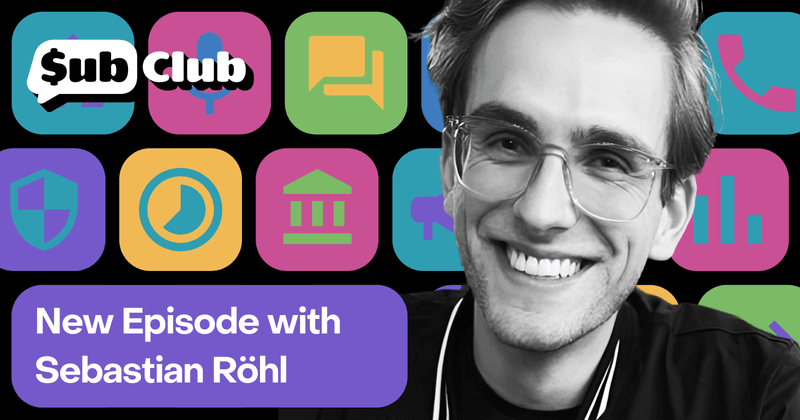“The first idea isn’t really that important… just start moving and build anything.” — Sebastian Röhl, HabitKit
Sebastian Röhl shares his journey from a corporate job to indie app success with HabitKit on the Sub Club podcast.

It’s the age-old question: should you keep your day job or quit to focus on your passion? If you’re an indie app developer, you’ve probably asked yourself this question at least once. After all, there are countless stories of indie developers building successful apps and making a living from their subscription app revenue. But leaving a stable, salaried job is a big decision that comes with significant risks. How do you know when (or if) it’s a good idea to quit and focus on building your app business full-time?
This week on the Sub Club podcast, we chatted with Sebastian Röhl, the creator of HabitKit, about his journey from corporate programmer to full-time indie app developer. Sebastian shared what motivated him to build a mobile app business, when and why he quit his corporate job, and the lessons he learned along the way.
Leaving the corporate world
In 2021, Sebastian was working a full-time corporate programming job when he started to feel the pull towards mobile app development. As a creative thinker, Sebastian wanted to have more agency in his work. “I’m the type of developer that likes to make his own concepts, think about how a problem should be solved, and then develop it myself and see that concept in the real world,” he said. So he made a big decision. With a bit of money saved up to cover his living expenses, Sebastian quit his corporate job and gave himself 12 months to build a mobile app business.
If at first you don’t succeed
Imagine you build an app, launch it on the app stores, and then… you make $100 in six months. This is unfortunately what happened when Sebastian released his first app, Liftbear. With an average of only 10 weekly downloads, Liftbear just didn’t take off the way Sebastian had hoped. He stuck with it for a few months, adding some new features, optimizing his app store listing, and even doing some marketing on Instagram. But in the end, he realized the app wasn’t going anywhere. “After six months, I couldn’t take it anymore,” he said. “I knew if I wanted to keep working on this app business, I needed to make some changes.”
Early success signals
After Liftbear’s release, Sebastian gave himself two months to build and launch a second app, HabitKit. And from the beginning, there were signs that this new app would be more successful than the first. “I was building in public on Twitter and the first time I posted a picture of the main screen of HabitKit, the post totally blew up — it got 800 likes. That was the moment when I knew, okay, this could be more successful than Liftbear.”

After he launched HabitKit, Sebastian made $1.5k in the first month (more money than he’d made in the last six months with Liftbear). But while this was a promising signal, he was nearing the end of his self-imposed 12-month deadline and had to face another tough decision: should he go back to his corporate job? In the end, Sebastian decided to return to his old job and continue working on HabitKit as a side project.
Becoming a full-time indie developer
In June 2023, two months after Sebastian returned to work, HabitKit suddenly took off. The app had started to rank in the top five search results for a major keyword, which led to a huge increase in downloads and revenue. By September, the app was bringing in thousands of dollars and once again, Sebastian had to make a tough decision. “Should I continue at my job, or should I quit and go full time on this indie hacker thing? I had to take a couple months to think about it because I felt sorry for my employer, and I had some great friends at the company,” he said. “But with those numbers, I honestly had no choice.”
By the end of 2023, HabitKit had 120k downloads and generated $51k in revenue. And so far the numbers for 2024 are even better: from January to May, HabitKit brought in $110k in revenue. Now Sebastian is planning to build on this success by adding new features to HabitKit, leaning into ASO strategies, and building community via social media and email marketing.
The biggest lesson we took away from Sebastian’s story? Sometimes, a lackluster launch is a sign that your app doesn’t have sufficient product-market fit to be a viable subscription app business. That’s why it’s so important to launch quickly and fail fast. The sooner you learn that there isn’t sufficient product-market fit for your app, the sooner you can pivot to a more promising idea.
You might also like
- Blog post
Modeling attribution on iOS: what works, what doesn’t, and how to choose
How to navigate the messy world of SKAN, AEM, and probabilistic attribution — plus two practical frameworks to get a clearer picture of campaign performance.
- Blog post
Your sprints must pay for themselves: Dan Layfield’s product advice
What’s worth building? Dan Layfield shares a 3-bucket framework to help app teams prioritize features, fix churn, and ship faster.
- Blog post
Is monetization hurting your app’s user experience?
Don’t trade short-term revenue for long-term trust. How ethical UX can still drive effective monetization.

